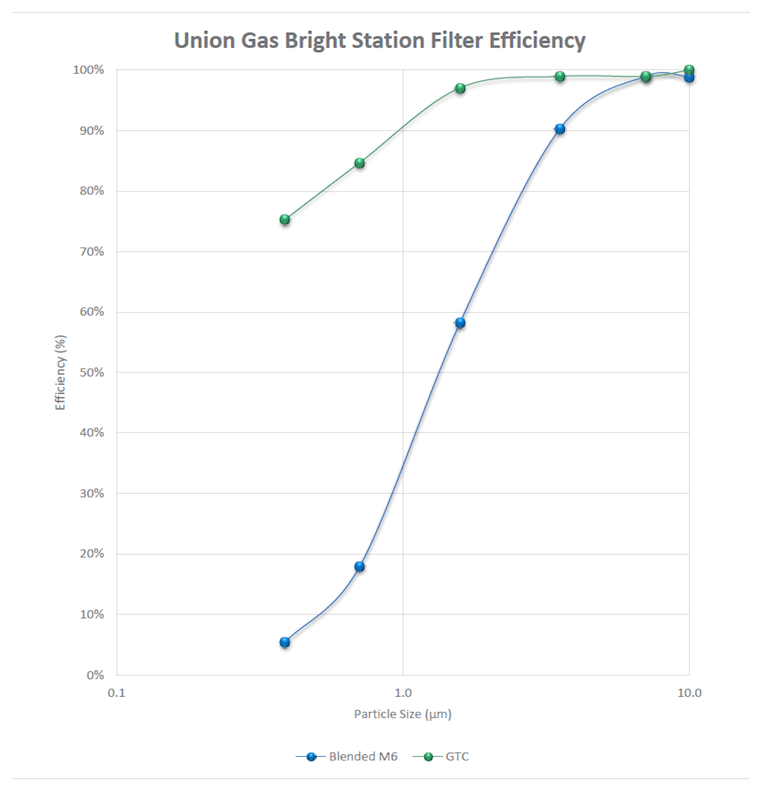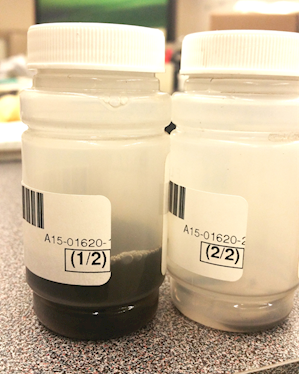Side by side comparison shows the benefits of higher grade filtration even in very clean rural areas.
Union Gas' Bright Compressor Station has two RB211 gas turbines that were installed 25 years ago with tenkay style pulse inlet systems. As part of their maintenance excellence program, and in order to optimize their soak wash schedule, Bright's operations staff began searching for potential filtration upgrades. These upgrades essentially allow for continuous operation during winter, therefore eliminating the need to shut down the turbines for maintenance. To determine whether they could improve operations, Bright received a free consultation with Camfil to better understand the latest media developments.
Blandford-Blenhein is a very clean, low dust rural area located in Ontario, Canada. The PM2.5 dust concentration averages 6 µg/m3. In comparison, the average USA PM2.5 concentration is 9 µg/m3 1. With 6 µg/m3, the area is cleaner than 90% of all sites. Despite the clean conditions, the turbines were fouling. As a result, staff would have to soak wash the engine offline every 1000 hrs and would experience 2.5 MW of power degradation (6% of the total output) over that period.
In order to understand filter performance and impact on the turbines, a side-by-side performance comparison test was conducted between Bright‘s existing filters (M6 blended filters) and Camfil‘s GTC F92 (ISO ePM1 80) synthetic filters. To measure the efficiency of both filters, a particle counter measured the concentration of particles before and after the filters. The compressor cleanliness was then evaluated with the particle concentration in the soak wash fluid. Finally, fuel consumption, as well as the impact on compressor performance was tracked for over a year.
As compared to the blended filters, the GTC filters showed increased efficiency without an increase in airflow restriction. After 1000hrs, the efficiency on 0.4um particle penetration was 75% as compared to the blended media efficiency of 5%. This resulted in a cleaner engine, a higher stable compressor efficiency, and lower fuel consumption.
Despite the difference in efficiency, both the blended and GTC filters have the same ASHRAE MERV 163 rating. The ASHRAE standard tests filters from initial efficiency, which may be electrostatically charged; they are also loaded quickly to their maximum capacity. Both the electrostatic charge and the dust loading have a positive impact on filter efficiency and as such can exaggerate filter performance, resulting in a high classification. In real life, any charge would wear off rapidly, causing efficiency to plummet. When the filter is loaded in the lab, or if installed in a very high dust area, efficiency would increase due to dust build-up on the filter – that dust cake acts as an additional barrier, allowing it to capture smaller particles, therefore increasing average efficiency.
When a site is extremely clean, a filter may stay at its minimal discharged efficiency for years since the electrostatic charge wears off and there is not enough dust accumulation for the efficiency to increase. This may cause fouling, corrosion, or plug the cooling holes of the turbine, which can cause an increase in temperature, shortening the life of the turbine blades.
Contrary to ASHRAE, the EN779: 2012 standard requires both an average efficiency and a discharged minimal efficiency, starting from the F7 filter class. The blended filters at Bright do not meet the minimum discharged efficiency requirement and therefore are classified as an M6. The GTC filters have a minimum discharged efficiency of 70%, meeting the F9 requirements.
Accordingly, especially in very clean, low dust environments, it is very important to verify the minimal efficiency of a pulse filter. An F9 is the minimum recommended grade; soak washing would be needed significantly less often than with a lower filter class.

"Union Gas Limited teamed up with Camfil to test out the new GTC F9 filter for one of the compressor units (RB211 G DLE) in UG fleet located near Bright Town in Ontario. Based on the comparative analysis with M6 blended filters, the new filters provided much better filtration and there was stark improvement in engine cleanliness leading to better air compressor efficiency of the engine" — Syed Hasan, Compressor Operations Engineer at Union Gas
| Filtration Data |
M6 Blended* |
Camfil GTC F9* |
| Efficiency on 0.4 µm after 1 year |
5% | 75% |
| Average Filter dP (" w.g.) |
0.32 | 0.34 |
| Engine Cleanliness Particle Concentration 2 µm and over in water wash fluid after 1000 hr runtime |
1020 mg/L | 220 mg/L |
| Compressor Efficiency Lost Power over 1000 hours (%) |
6% | 1% |
| Increased fuel consumption due to fouling |
2.2% | 0.3% |
| ASHRAE MERV Rating | MERV16 | MERV16 |
For the Bright team, the higher efficiency and stable pressure drop of the GTC filters translated in fouling reduction and showed a direct correlation to improved compressor efficiency.
For Bright, it meant:
Image: Soakwashing fluids from the M6 (left) blended media compared to an F9, GTC (right) after 1000 hrs run time

The GTC is a 3-dimensional media with depth loading properties and constant high efficiency. Its synthetic fibers offer more strength and better performance even under high humidity conditions. Moreover, the smooth synthetic fibers offer low impedance to airflow resulting in lower pressure drop. In addition to media performance, the Hemi-PleatTM's open pleating technology in Camfil cartridges offers wider spacing, exposing more surface media to the air stream. These features result in:
1 http://www.epa.gov/airtrends/pm.html : PM2.5 dust concentration of 6µg/m³ is the mass of particles below 2.5 microns/m³
2 F9 per EN779:2012 : European filter rating system : F9 = 95% average efficiency on 0.4 µm, 70% minimal efficiency; ISO16890 ePM1 80%
3 ASHRAE is a USA standard filter rating system; its rating system is the Minimum Efficiency Reporting Value (MERV)
* Per EN779:2012 standard; ISO16890 ePM1 80%